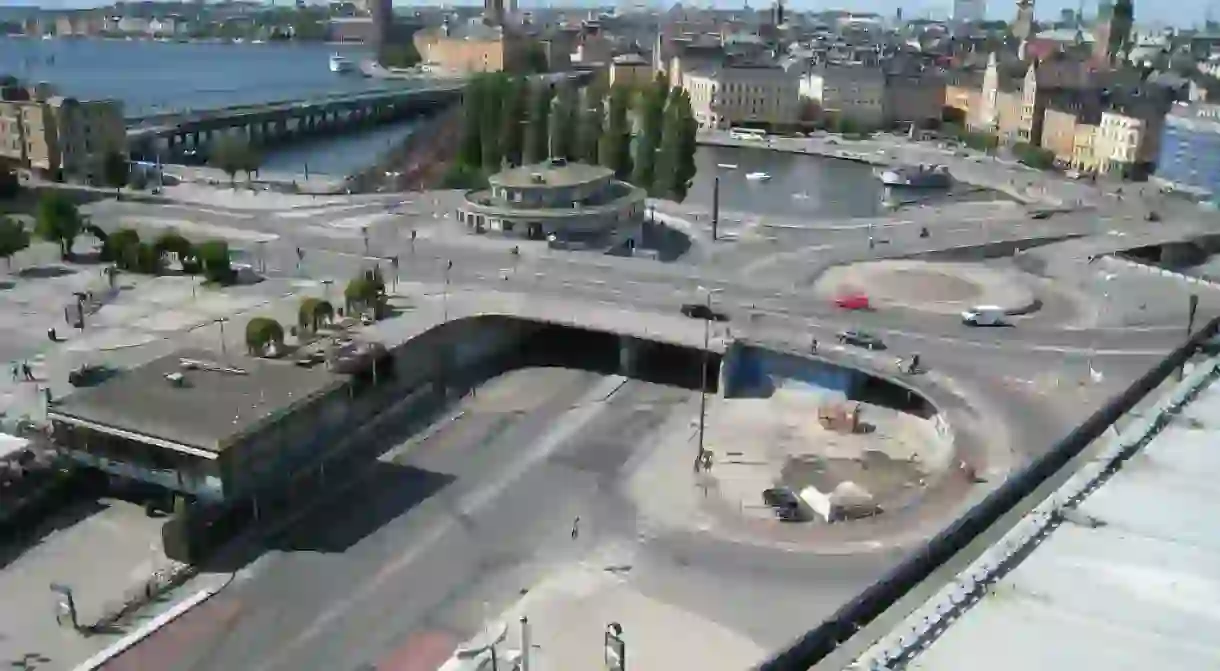Stockholms Biggest Transport Juncture Has a Surprisingly Dynamic History

In every major city, there is always a particular bone of contention when it comes to transport. In Edinburgh, it is the trams where a great deal of money was spent, with arguably little pay off for travelers. In London, it is how busy the tube gets during rush hour. In Stockholm, ask any local about the redevelopment of Slussen, and they will roll their eyes and sigh.
The origin of Slussen
One of the most interesting things about this sense of frustration and dismay at the ongoing work at Slussen, one of Stockholm’s transport hubs, is the fact that it is nothing new in the city. The term “Slussen misery” first appeared in Stockholm’s newspapers way back in 1920.
In fact, the history of Slussen goes all the way back to the 17th century, when the city first tried to build an interchange for boats that needed to go between Lake Malaren and the Baltic Sea. The interchange was named Slussen.

Locks on locks on locks
A key reason Stockholm grew into the city it is today and gained so much importance within Northern Europe is because it is based on fourteen islands. This made it a very important port with routes out onto the Baltic Sea.
Between two of Stockholm’s major islands, Gamla Stan (the old town) and Sodermalm, is Slussen, which is where Lake Malaren and the Baltic sea meet. The water levels change between these two bodies of water, meaning that Stockholmers needed to install a lock for boats to be able to pass.
The city began dealing with this issue by constructing Queen Christian’s lock in 1642, but as traffic increased, a larger lock was needed and the Christopher Polhem Lock was built in 1751. However, even that was not enough and the Nils Ericson lock was completed in 1850.

Trains, horses, and automobiles
Trains then began to cross between the islands, as did foot traffic. Then horses and carts and more boats began to flood into the area, creating congestion in Slussen.
This traffic meant people became more and more frustrated and eventually it was decided that something had to be done to combat the misery, with the arrival of cars tipping it over the edge. Thus the city decided that they would invest and totally rebuild the area and in 1931 determined they would build a new lock, as well as a highly innovative cloverleaf style exchange for cars and other traffic.

Slussen in the 21st century: still a work in progress
However, over the years, people continued to have problems with Slussen—especially once the metro system was extended out to the interchange in 1950.
At the time, it was revolutionary and was designed to be as future-proof as possible, hence a focus on cars, which at that time seemed like the future of transport.
Today, over 640,000 public transport passengers pass through Slussen each day, either by metro or bus. It has become a place full of people—however, it is not a place for people to stop and to meet others because it is built for cars rather than people.

It remains the kind of place that you want to get in and out of as quickly as possible. There are some interesting things surrounding the station—including the Stomatal sign, which is Sweden’s oldest animated sign, but no one would ever spend more time in Slussen than they need to.
That is why, in 2009, the city decided that they would renovate it again. In doing so, they would try and create a new Slussen, which was built for the modern age of mass public transit and to give people a place where they could enjoy.
Will it ever be finished?

It is a noble idea with great intentions. Stockholm municipality wants to add a park and plaza, as well as a new bus terminal and more space for cyclists.
However, since 2016, when the interchange was closed, getting in and out of Slussen has become a nightmare.
Cars have had their journeys elongated, metro passengers have arrived to find their usual exit blocked and bus passengers have had their stops moved more times than they can count. The work will continue for at least the next six years and likely longer.
It will be interesting to see how Slussen turns out when it is finally completed. It will perhaps be worth it, but it is unlikely that Slussen will ever be perfect, despite over three hundred years of trying.













